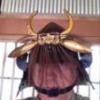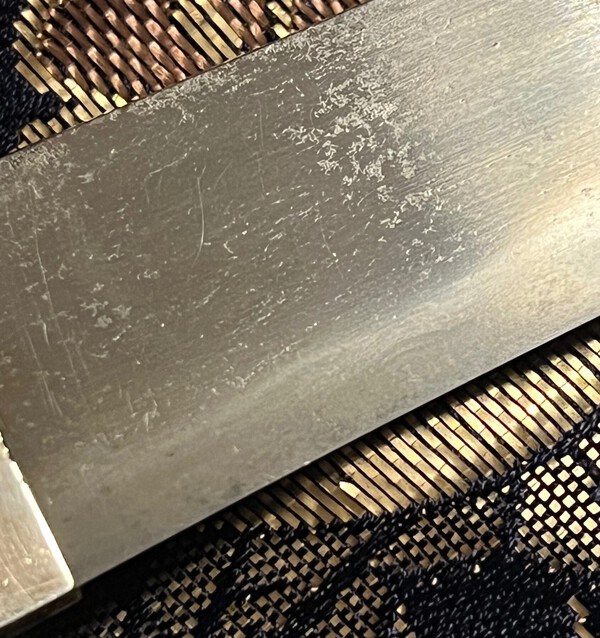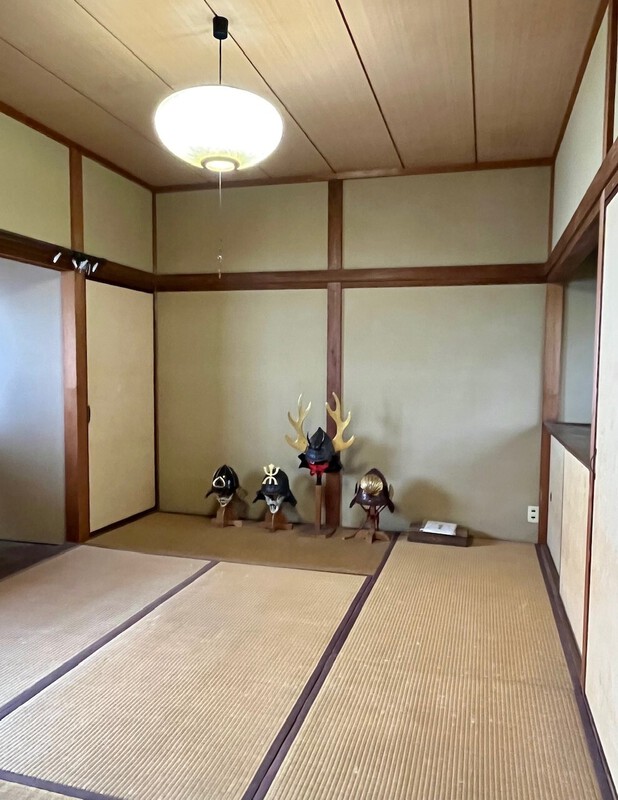-
Posts
14,049 -
Joined
-
Last visited
-
Days Won
257
Content Type
Profiles
Forums
Events
Store
Downloads
Gallery
Everything posted by Bugyotsuji
-
Ah, now I understand where you are coming from. Thank you. Yes, that makes sense. I spent some time just now trying to find some evidence of hamon that could actually be photographed under the kitchen light! Will check the shots and see if anything came up... warts and all. May be beyond redemption.
-
At the munemachi Lewis, the kasane is roughly 0.6 cm by my non-digital Shinwa. The thickest part of the nakago is just behind that at 0.7 cm, covered by the habaki.
-
Not sure Lewis. I'll get it out and measure it. (That's the thickness at the habaki, right?) Yes, I love these little bashin, though they do not come up too often.
-
Re Hidetsugu/Eiji Mei. Visiting the place where my books have been moved to, I found the book I wanted and looked up the Mei on the fuchi. There were three Kinko artisans with the name Eiji 英次. I wonder which one might have signed with just 英次+Kao. This Yokoya school work has similarities: 小柄 貞義(花押) 伊勢海老図 | 日本刀・刀剣・名刀・短刀の販売・通販・買取は和敬堂へ Photo of entry follows below... .
-
Well, I hope so Alex. If/when there is any interesting update, I’ll post here.
-
Thanks for the feedback, Ray. Food for thought...
-
Recently I bought a melange tanto more for the tosogu than for the blade. I was debating whether to put it under Nihonto here or under Tosogu, but since it is a registered blade I have decided to respect that. 1. The blade is slim, but with thick kasane. The condition is not good, to put it politely. One side has the remains of 八万大菩薩 Hachiman Dai Bosatsu. The other has a small pit or hole in it. The hamon is suguha, but does not scream anything special to me. The silver habaki fits very tightly, but there is no tsuba, more like one thick silver seppa. It is unsigned, so cannot be declared gimei! I have a bag of Tantō tsuba, but none fits, like the ugly sisters’ feet and Cinderella’s slipper. 2. The Saya is an interesting lacquer finish, and the saya fittings are iron: there is an iron bashin in the narrow slot. The tsuka menuki are two branches of Japanese apricot (plum) in shakudo and gold. The shakudo fuchi has a wonderful suaka lobster on a fine nanako ground, and is signed Hidetsugu + kao. The work is good but the Mei could have been added later. The kashira is also shakudo with nanako-ji, and the design looks to be noshi (?) jinja hangings. My plan is to show this to some artisans and get feedback on it. Is the package worth saving, or improving? Will I be having the blade polished, for example, or should it be left alone as a kind of tsunagi? Should I let this one slip quietly back into the market? General shots follow...
-
I can't see that in my mind's eye, Stephen. Why would it need to roll back and forth?
-
Nice print. Might be worth noting that old kabuto bowls made with joined (riveted) triangular sections generally fell into two types, 'suji kabuto' (as in your print) and 'hoshi kabuto'. Hoshi ('stars) kabuto had spiked rivets protruding from the surface, whereas suji kabuto had a flat/smooth surface and the seams were usually either visible or even accentuated with standing edges.
-

Edo Period Corner Part II
Bugyotsuji replied to estcrh's topic in General Nihonto Related Discussion
Michael, sadly/happily, most of what we wear is genuine old armour, generally Momoyama to Edo period. There are some bits (small primer flasks, footwear etc.) that we sometimes make up but in our troop we pride ourselves on trying to keep it all authentic as much as possible. The kabuto that I am wearing recently has special value papers for example, and I regularly wear all of the kabuto you see in the empty room above. This means that we have to learn how to repair sympathetically as there is constant damage and degradation. (Personally speaking I have a 'good' old pair of sune-ate, which I switch around with a pair from Marutake, to slow such degradation, depending on the weather and the venue.) At the moment I am doing an armo(u)r society translation, and once again giving thanks for the years of experience wearing and repairing and the familiarity with this and that word or expression. And yet there is still so much I do not know. (There are re-enactment troops and festivals where everyone wears repros, though, as you know.) As to the swords, they are all genuine koshirae, but owing to the laws here the blades inside are substitute tsunagi/takemitsu. Once after a public display a member of the public tried to draw my sword, without permission! The guns are all real too, repros not being permitted under Japanese law. My oldest one, a Kunitomo pistol that you can see being fired in the first video, is from around 1600 -1610. She played a trick on me though. Oops... -
Wow!Why is that one described as dried abalone, I wonder? Slices, chunks? 干鮑 hoshi awabi
-

Edo Period Corner Part II
Bugyotsuji replied to estcrh's topic in General Nihonto Related Discussion
Peter, the short fat 100 was fired first, by Kaneishi Hiro Kun in red katchu. He is from Takahashi. You'll see our leader showing the fire bolt around to the spectators. (Anthony and Marjolijn call it their "baby whale".) The gun you kindly sourced is the longer one, fired last, closer to the camera, by Takahashi Kun in black, from the south of Okayama. Mr Koike the shirogane-shi habaki maker has sprained his wrist, so he is taking a break from firing it for the time being as he needs the use of his wrists for work!!! This is good, though, as it trains younger members to be able to step up and take over one day. There is another view of your gun being fired, seen from further away but giving a very good idea of the blast and smoke travel. It's on X. I wonder if I can link it? https://x.com/kuroku...081786317729942?s=46 -

Edo Period Corner Part II
Bugyotsuji replied to estcrh's topic in General Nihonto Related Discussion
One is best not to assume… -

Edo Period Corner Part II
Bugyotsuji replied to estcrh's topic in General Nihonto Related Discussion
All good things must come to an end. Leaving this house after 30+ years. It’s been good for the family. Sigh. Now, have I left anything behind? -

Edo Period Corner Part II
Bugyotsuji replied to estcrh's topic in General Nihonto Related Discussion
Ah yes, it was ringing a bell. What a thing, though! It must weigh around 50+kg…(?) -
That’s pretty scrambled, Grev …
-

Edo Period Corner Part II
Bugyotsuji replied to estcrh's topic in General Nihonto Related Discussion
Jean, where is that? -
All things considered, I think you have done a good job. It may need to settle down a bit, and you can get some handling into it, without application of hand creams, etc.!
-

Edo Period Corner Part II
Bugyotsuji replied to estcrh's topic in General Nihonto Related Discussion
Video continues here... -

Edo Period Corner Part II
Bugyotsuji replied to estcrh's topic in General Nihonto Related Discussion
Quick update on the blackpowder displays this autumn. We had one every weekend from the end of September until the 17th of November, meaning very heavy usage, with much cleaning and repair of guns and armor. The most recent event was for the Martial Arts Kobudosai where we fired our big guns indoors, nearly blowing the roof off the place. Nine matchlock tanzutsu/bajozutsu pistols. Hand cannons: One 20 Monme big gun. "Ni-ju Mon-me!" Three 30 Monme followed. "San-ju Mon-me!" Three 50 Monme next. "Go-ju Mon-me!" Two 100 Monme for the finale. "Hyaku Mon-me!" (1. Short 100 Monme hiyazutsu for firing bo-hiya or flaming bolts. 2. Long 100 Monme gun.) (Many thanks to Peter in Belfast and Anthony in Stockholm for sourcing the two largest guns for us. Both are lovingly used and looked after.) WARNING! NOT office friendly In December, at the request of the tourist board, there will be a (chilly) evening double-header with thunderous flashes in the grounds of Okayama Castle, on both the 7th and 8th, ...and that should finally wrap up the year. Phew! -
Hang in there and look forward to the relief! (It looks like a yoroi-doshi from here.)
-
I have an example of the top one Alex, small but heavy.
-
The back is good too.














